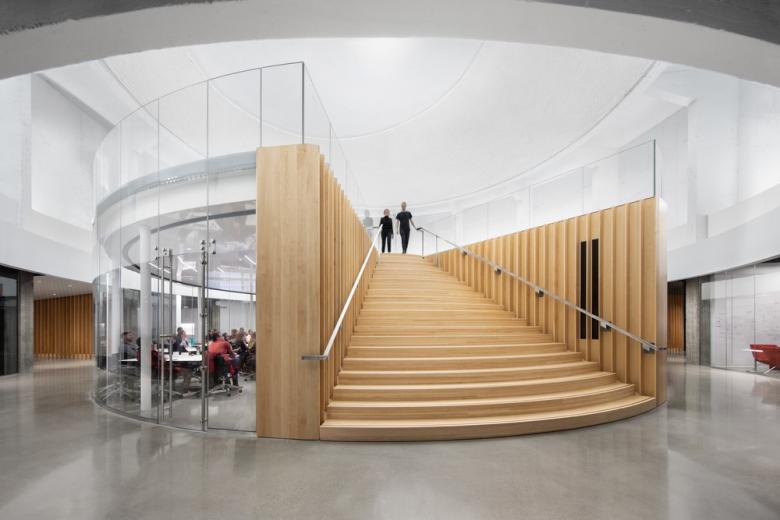Menkès Shooner Dagenais LeTourneux Architectes
ÉTS Centech
Menkès Shooner Dagenais LeTourneux Architectes
13. dezembro 2018
Photo: Stéphane Brügger (All photographs courtesy of v2com)
A new vocation for the former Dow Planetarium, now home to ÉTS Centech, one of the largest technology company accelerators of in Canada.
Project: Conversion of ÉTS’s Dow Planetarium, 2018
Location: Montréal, QC, Canada
Client: École de technologie supérieure (ÉTS)
Architect: Menkès Shooner Dagenais LeTourneux Architectes
Partner in Charge: Anik Shooner
Lead Designer: Jean-Pierre LeTourneux
Project Manager: Julie Morin
Projet Team: Mehand Aziz, Frédérick Dumas, Sylvain Gagné, Pierre Gervais, Marc-Antoine Grondin, Mario Isa, Claude Labbé, Louis Laperrière, Gaspard Marier, Anne-Marie Nguyen, Joanne Parent
Structural Engineer: SDK
Mechanical-Electrical Engineer: Bouthillette Parizeau et Associés
Civil Engineer: GHD
Glazing: CPA Verre Structurel inc.
Acoustical: SNC-Lavalin
Landscape Architecture: NIP Paysage
Site Area: 6,000 m²
Building Area: 2,000 m²
Photo: Stéphane Brügger
Closed since 2011 after 45 years of existence and transferred to the École de technologie supérieure (ÉTS) by the City of Montreal, the conversion project by Menkès Shooner Dagenais LeTourneux Architectes aimed to rehabilitate this iconic building located at 1000 St. Jacques in Griffintown, in the heart of the Quartier de l’Innovation to welcome Centech, a business incubator. Founded by ÉTS, Centech is a non-profit organization that aims to support technology companies by promoting their economic development and technology transfer.
Photo: Stéphane Brügger
In the spirit of creating synergies between the university community, the business community, the citizens and the ÉTS community, the new vocation of the Planetarium commissioned the typology of spaces: spaces to encourage encounters, collaboration and reflection linked to tools and advanced technologies, spaces of social diversity and exchange platforms for sharing knowledge.
Photo: Stéphane Brügger
Design approach and architectural challenges
The main architectural challenge met by Menkes Shooner Dagenais LeTourneux Architectes was to find a way to bring light into the heart of this building designed and intended, by definition and function, to be both obscure and opaque while preserving the memory and the nature of the place, inscribed in the imagination of Montrealers.
Photo: Stéphane Brügger
The choice to develop the project around the concepts of revolution (about an axis) and the circular shape, imposed by the intrinsic nature of the building, was decisive. Inspired by the perpetual movements of the universe and by the curious complexity of ancient instruments such as the astrolabe or the Orrery machine that translate it, the team of architects transformed the former Dow Planetarium not only into a place that allows to see and explains the cosmic movement, but into a dynamic place which uses it. The era of observation having gone by, this building becomes a generator, accelerator and source of inventions.
Photo: Stéphane Brügger
Beyond the materiality, the architects have thus favored the formal language to make the movement and this acceleration real and perceptible: from the gears that recall walls composed of a juxtaposition of vertical slats to the concentric circles which are superimposed in the plan, everything is about mechanical rotation and spinning.
Photo: Stéphane Brügger
The center of the building is an open circular space accessible on all sides and that controls the entire spatial organization of the building. Designed to be the heart of the accelerator in the image of a crucible of innovation and announcing the premises of what will be created in this place, it is intended for unplanned encounters and opportunities that are often at the origin of the greatest discoveries.
Photo: Stéphane Brügger
The mechanics of the rest of the building are entirely articulated around this central space. Similar to the ingenious principle of watchmaking and the cogwheel, a concentric circulation path leads to the café, the meeting space and the ideation room that wrap around and revolve about a solidary and precise mechanism.
Photo: Stéphane Brügger
Attached to this rotational movement along the main axis of the building, spaces intended for businesses that will accompany creators on their journey of technological creation complete this clever device.
Photo: Stéphane Brügger
Special technical features:
- Curved glass walls: Complex work to realize and some walls, acting both as partitions and guardrails (great height), required oversized glass panels.
- Use of curved laminated timber: Used both as a structural and finishing component in the two monumental staircases.
- Polished concrete slab: The ventilation and all other electromechanical components built into the slab required tight and constant coordination during construction.
- Electromechanical components: They are all located below the floor slab. This approach made it possible to free up the existing caisson ceilings and allow full-height glass walls.
- Acoustics: Acoustic foam and panels were integrated into the particular volumetry related to the previous use of the premises.
Photo: Stéphane Brügger
Artigos relacionados
-
ÉTS Centech
on 13/12/2018
-
Monument
on 22/10/2018
-
Webster Library at Concordia University
on 27/03/2018
-
'La Géode'
on 04/10/2017










